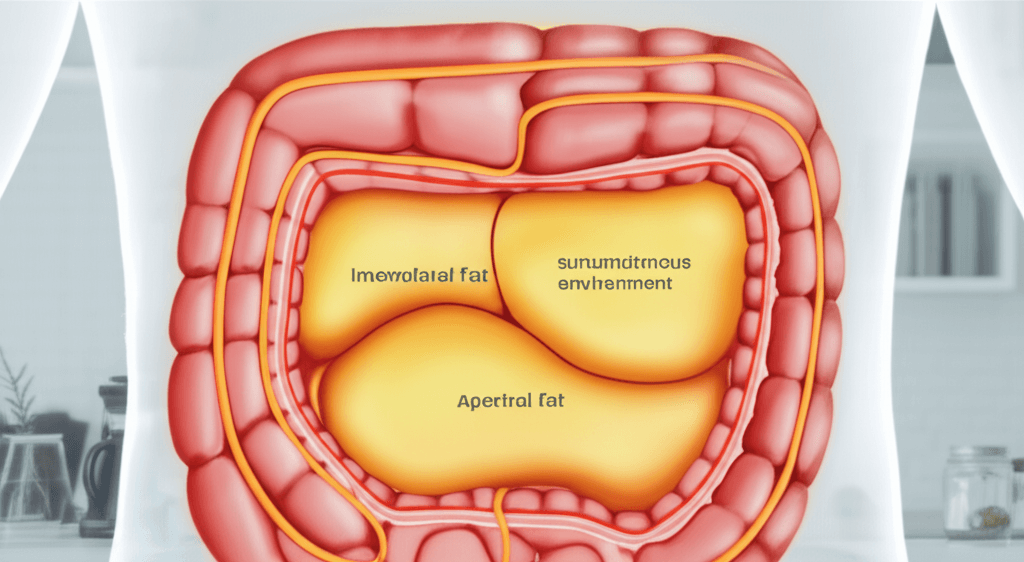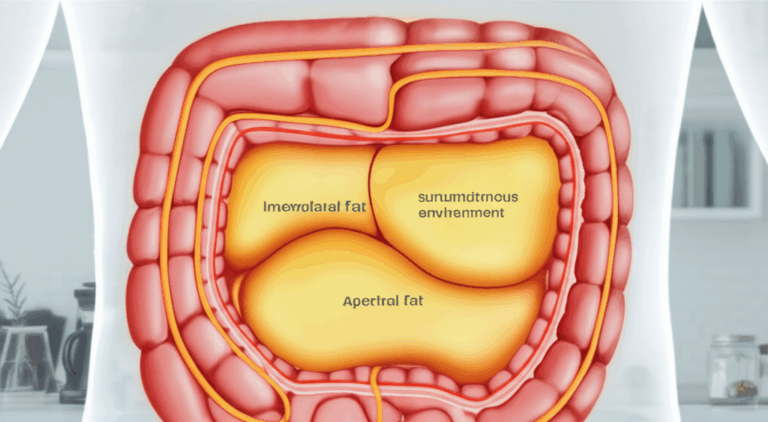Stubborn belly fat, particularly visceral fat that wraps around your organs, is more than just a cosmetic concern; it’s a significant indicator of metabolic dysfunction and heightened health risks, including heart disease, type 2 diabetes, and certain cancers. While many seek quick fixes, metabolic doctors emphasize a natural, sustainable approach that addresses the root causes of fat accumulation, focusing on resetting the body’s natural rhythm through diet, lifestyle, and movement.

Understanding Belly Fat: More Than Just Aesthetics
Belly fat exists in two main forms: subcutaneous fat, which is visible and lies just under the skin, and visceral fat, which is deep within the abdominal cavity, surrounding vital organs like the stomach, liver, and intestines. It’s this visceral fat that is metabolically active, secreting pro-inflammatory cytokines and increasing the risk of chronic diseases. Losing belly fat, especially visceral fat, not only improves appearance but also enhances blood vessel function and sleep quality.

The Metabolic Root of Belly Fat Accumulation
Leading metabolic health experts, such as Dr. Mark Hyman and Dr. Jason Fung, highlight that diet and lifestyle are primary drivers of belly fat. High consumption of refined sugars and starches leads to elevated insulin levels, a hormone that signals the body to store more food energy as body fat. Beyond diet, chronic stress, insufficient sleep, and inadequate physical activity also contribute to metabolic imbalances that favor belly fat storage.

Core Principles for Natural Belly Fat Loss
A natural approach to reducing belly fat centers on recalibrating your body’s metabolic signals, rather than just calorie counting.
Prioritize Whole, Unprocessed Foods
Eating real, nutrient-dense foods helps regulate appetite, reduce inflammation, and improve insulin sensitivity. These foods are typically rich in vitamins, minerals, and fiber, contributing to greater satiety and reduced overall intake.
Embrace High-Quality Protein
Including protein in every meal can keep you feeling fuller for longer, reduce hunger hormone levels, and support lean muscle mass, which is crucial for metabolism. Aim for adequate protein spread throughout the day.
Boost Soluble Fiber Intake
Soluble fiber forms a gel-like substance in the digestive system, slowing down food passage and promoting feelings of fullness, which can lead to reduced calorie intake. Foods like lentils, beans, oats, apples, and berries are excellent sources.
Minimize Added Sugars and Refined Carbohydrates
Excess added sugar is directly linked to increased belly fat accumulation. Cutting out sugary drinks, refined flours, and processed snacks can significantly impact belly fat, as these cause rapid blood sugar and insulin spikes. The World Health Organization advises keeping “free sugars” under 10% of daily calories, ideally below 5%.
Leverage Intermittent Fasting
Intermittent fasting, an eating pattern that cycles between periods of eating and voluntary fasting, is a powerful tool for weight loss and specifically targeting belly fat. By extending periods of not eating, insulin levels drop, allowing the body to burn stored fat for energy. Common methods include 16/8 fasting (eating within an 8-hour window) or alternate-day fasting.
Prioritize Quality Sleep
Lack of adequate sleep can disrupt appetite hormones (leptin and ghrelin), increase cortisol (a stress hormone that promotes fat storage, especially in the abdomen), and contribute to insulin resistance. Aim for 7-8 hours of quality sleep per night. Establishing a consistent sleep schedule and creating a relaxing bedtime routine are vital.
Manage Stress Effectively
Chronic stress elevates cortisol, which can lead to increased fat storage around the midsection. Finding effective stress management techniques, such as mindfulness, meditation, or spending time in nature, is important for metabolic health.
Incorporate Regular Movement
Regular physical activity helps burn abdominal fat by reducing circulating insulin levels and prompting the liver to use fatty acids from visceral fat deposits. Aim for at least 30-60 minutes of moderate to vigorous exercise most days of the week. Both aerobic exercise (cardio) and strength training are beneficial, with strength training helping to build muscle mass, which burns more calories at rest. Even incorporating more steps into your day, such as 10,000 steps daily, contributes significantly. High-intensity interval training (HIIT) can be particularly effective for burning fat faster.
Limit Alcohol Consumption
Alcohol, especially in daily habits, contributes to excess calories that often go directly to belly fat. Reducing alcohol intake can significantly aid in belly fat reduction.

A Sample 7-Day Routine Framework for Natural Belly Fat Reduction
This framework synthesizes the principles advocated by metabolic doctors to help naturally reduce belly fat. Remember, consistency and listening to your body are key. This is a sample plan and should be adapted to individual needs and preferences.
Day 1: Foundation and Early Eating
- Diet: Focus on whole, unprocessed foods. Start the day with a high-protein breakfast (e.g., eggs or a protein shake). Include lean protein and plenty of non-starchy vegetables at lunch and dinner. Eliminate all added sugars, refined carbs, and sugary beverages.
- Hydration: Drink plenty of water throughout the day. Replace sugary drinks with water.
- Timing: Aim to finish your last meal at least 3 hours before bedtime to support metabolic health and sleep. Consider an early dinner, perhaps by 7:00 PM.
- Movement: Engage in a moderate-intensity walk for 30-45 minutes.
- Sleep: Prepare for sleep by dimming lights and avoiding screens 60-90 minutes before bed. Aim for 7-9 hours of sleep.
Day 2: Fiber & Protein Optimization
- Diet: Continue whole foods focus. Deliberately increase soluble fiber intake through foods like oats, beans, lentils, and apples. Ensure protein at every meal, aiming for 30-50 grams, particularly at breakfast.
- Timing: Maintain early dinner.
- Movement: Incorporate 30-45 minutes of aerobic exercise (e.g., brisk walking, cycling, or light jogging).
- Lifestyle: Practice a 10-15 minute stress-reduction technique, such as deep breathing or meditation.
Day 3: Introducing Time-Restricted Eating
- Diet: Continue whole foods, high protein, high fiber.
- Timing: Introduce a 12/12 or 14/10 intermittent fasting window (e.g., eating within a 12 or 10-hour window, and fasting for 12 or 14 hours). For example, if you finish dinner by 7:00 PM, delay breakfast until 7:00 AM or 9:00 AM. Eliminate all snacks outside your eating window.
- Movement: Focus on resistance training for 30 minutes, using bodyweight exercises or weights to build muscle.
- Sleep: Reinforce good sleep hygiene.
Day 4: Active Recovery & Hydration
- Diet: Consistent with previous days. Consider warm cumin or carom (ajwain) water in the morning, which some traditions suggest aids digestion and weight management.
- Timing: Continue your chosen intermittent fasting window.
- Movement: Engage in gentle movement like yoga, stretching, or a leisurely walk to aid recovery and reduce stress.
- Lifestyle: Focus on active relaxation—anything that helps you unwind and reduce mental load.
Day 5: Deepening Fasting & Cardio Boost
- Diet: Maintain high-quality, nutrient-dense meals.
- Timing: If comfortable, gradually extend your fasting window to 16/8 (e.g., eating from 12 PM to 8 PM). This can be done progressively over weeks.
- Movement: Perform 30 minutes of moderate to high-intensity cardio or try the Japanese walking technique: alternating 3 minutes of speed walking with 3 minutes of regular walking for five rounds.
- Sleep: Ensure a consistent bedtime to optimize sleep hormones.
Day 6: Nutrient Optimization & Gut Health
- Diet: Continue emphasis on lean proteins, healthy fats (like avocados and extra virgin olive oil), and a diverse range of colorful vegetables and fruits. Consider adding fermented foods like Greek yogurt or kefir for gut health.
- Timing: Adhere to your intermittent fasting schedule.
- Movement: Mix of strength training and a moderate walk.
- Lifestyle: Review your alcohol intake and consider further reducing or eliminating it.
Day 7: Consolidate Habits & Plan Forward
- Diet: Reflect on the dietary changes and what feels sustainable.
- Timing: Solidify your intermittent fasting routine.
- Movement: Plan your exercise for the upcoming week, ensuring a mix of cardio and strength training.
- Review: Acknowledge your progress and identify areas for continued improvement. Focus on making these changes permanent lifestyle habits rather than a temporary diet.

Sustaining Your Progress Beyond 7 Days
While a 7-day routine can kickstart your metabolism and create new habits, sustainable belly fat loss is a long-term commitment. The key is consistency in applying these metabolic principles: prioritize whole foods, manage insulin through mindful eating and timing, engage in regular varied physical activity, optimize sleep, and control stress. Regularly assessing your energy, mood, and sleep can help you fine-tune your approach for lasting results. If you have underlying health conditions, consult with a healthcare provider to tailor a plan that is right for you.







